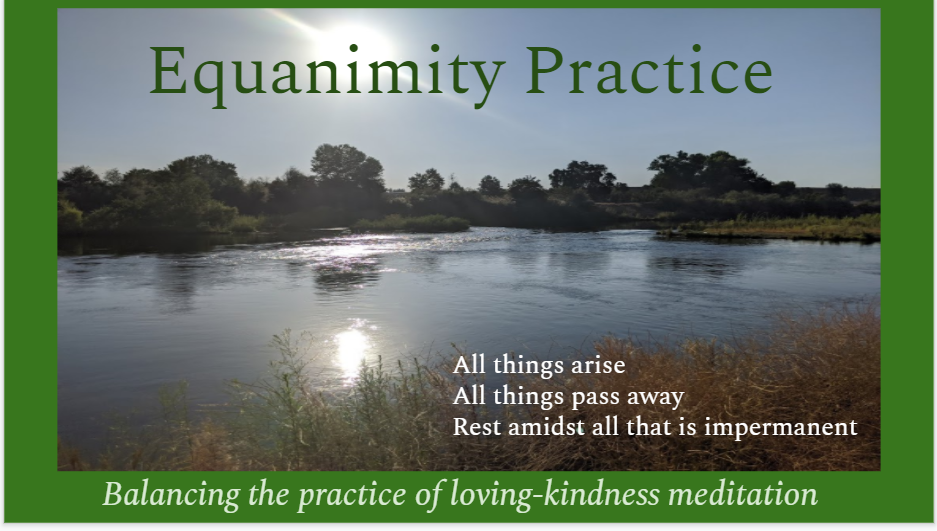Cultivating equanimity, the mental state of composure and balance, is a cornerstone of well-being. This guide delves into the profound practice of meditation as a powerful tool for developing equanimity. Through understanding various meditation techniques and practical applications, you’ll gain the skills to navigate life’s challenges with resilience and inner peace. We’ll explore the historical and philosophical underpinnings of equanimity, providing a holistic approach to this essential skill.
This comprehensive guide will systematically explore the core principles of equanimity, from defining the concept to practical application in daily life. It will provide a detailed overview of different meditation techniques, from mindfulness to loving-kindness, highlighting their specific roles in fostering equanimity. We will also delve into the challenges of cultivating equanimity and offer strategies to overcome them.
Introduction to Equanimity

Equanimity, a state of mental composure and emotional balance, is characterized by a calm acceptance of whatever life brings. It’s not about suppressing emotions, but rather about responding to them with clarity and a sense of detachment. Cultivating this inner peace allows for a more fulfilling and resilient approach to life’s inevitable challenges.Equanimity is a valuable asset in modern life, where stress and anxiety are pervasive.
By developing equanimity, individuals can navigate stressful situations with greater ease, reduce negative emotional responses, and foster a sense of inner peace that contributes significantly to overall well-being. It is a key element in effective stress management and a crucial step in building resilience.
Definition of Equanimity
Equanimity is a state of mental calmness and emotional stability, marked by evenness of temper and composure, regardless of external circumstances. It encompasses the ability to remain calm and focused in the face of challenges, difficulties, or emotional fluctuations. It involves accepting what is, without judgment or resistance.
Importance of Equanimity in Daily Life
Equanimity significantly impacts daily life by promoting a sense of inner peace and emotional regulation. It allows individuals to respond to challenges with a clear mind and a balanced perspective, reducing stress and promoting healthy coping mechanisms. This, in turn, enhances relationships, decision-making, and overall well-being.
Relationship Between Equanimity and Stress Reduction
Equanimity is intrinsically linked to stress reduction. By cultivating a state of mental balance, individuals can effectively manage stressful situations. They develop a greater capacity to observe and respond to stress triggers without being overwhelmed by them, fostering a sense of control and emotional resilience. This ultimately leads to a reduction in stress levels and improved mental health.
Historical and Philosophical Context of Equanimity
The concept of equanimity has deep roots in various philosophical and religious traditions, notably in Buddhism. In Buddhist philosophy, equanimity is a key component of the Eightfold Path, representing a state of mental balance and detachment from craving and aversion. This perspective emphasizes the importance of recognizing the impermanent nature of experiences and cultivating a non-judgmental attitude towards them.
Key Characteristics of an Equanimous Person
| Characteristic | Description | Example | Impact on Well-being |
|---|---|---|---|
| Acceptance | The ability to acknowledge and accept events, feelings, and circumstances as they are, without judgment or resistance. | A person facing a setback accepts it as a learning opportunity rather than dwelling on the negative aspects. | Reduces stress, promotes resilience, fosters a positive outlook. |
| Detachment | Maintaining a sense of emotional distance from external events and outcomes, without becoming overly attached or invested in the outcome. | A person loses a job but remains composed and focused on finding new opportunities, rather than becoming overly distressed. | Reduces anxiety, enhances emotional regulation, improves decision-making. |
| Non-judgment | Observing thoughts and feelings without labeling them as good or bad, right or wrong. | A person experiences anger but acknowledges it without criticizing themselves or others. | Promotes self-awareness, reduces reactivity, enhances emotional intelligence. |
| Calmness | Maintaining a state of inner peace and composure, regardless of external stimuli. | A person remains calm during a conflict, focusing on understanding the other person’s perspective. | Reduces anxiety, enhances communication, fosters healthy relationships. |
Understanding Meditation Practices for Equanimity
Developing equanimity, a state of mental balance and composure, is a valuable pursuit in navigating the challenges of daily life. Meditation provides a powerful pathway to cultivate this inner peace. By understanding and practicing various meditation techniques, individuals can gain insights into their thoughts and emotions, fostering a greater sense of stability and resilience.
Mindfulness Meditation
Mindfulness meditation is a cornerstone of cultivating equanimity. It involves paying non-judgmental attention to the present moment, observing thoughts, feelings, and sensations as they arise and pass. This practice helps to detach from the tendency to get caught up in the narratives of the past or anxieties about the future. Through consistent practice, individuals develop a deeper understanding of their internal experience, leading to greater emotional regulation and a more balanced perspective.
Practicing mindfulness meditation involves focusing on the breath, noticing physical sensations, and acknowledging thoughts and emotions without getting carried away by them. This process of observation allows one to develop a greater sense of detachment from these experiences, fostering equanimity.
Loving-Kindness Meditation
Loving-kindness meditation cultivates feelings of compassion and goodwill towards oneself and others. This practice involves generating feelings of love, kindness, compassion, and joy for oneself, loved ones, neutral individuals, difficult people, and all beings. By extending loving-kindness to all, practitioners expand their capacity for empathy and understanding, reducing feelings of isolation and negativity. This, in turn, contributes to a more balanced and equanimous state of mind.
Regular practice of loving-kindness meditation can promote feelings of warmth, acceptance, and connection. These feelings can counter negative emotions and cultivate a sense of inner peace, crucial elements in achieving equanimity.
Body Scan Meditation
Body scan meditation involves systematically bringing awareness to different parts of the body, noticing sensations without judgment. This practice fosters a deeper connection with the physical self, allowing practitioners to become more aware of bodily sensations and their impact on emotional states. By recognizing and accepting bodily sensations, individuals can reduce stress and anxiety, promoting a sense of groundedness and equanimity.
Through body scan meditation, individuals gain a heightened awareness of physical sensations, which often reflect emotional states. This awareness helps to manage stress and anxiety, ultimately contributing to a more balanced and equanimous perspective.
Comparison of Meditation Techniques
| Technique | Core Principle | Benefits | Application |
|---|---|---|---|
| Mindfulness Meditation | Non-judgmental awareness of the present moment | Emotional regulation, reduced stress, increased self-awareness | Developing focus, managing anxiety, and promoting a calm mind. |
| Loving-Kindness Meditation | Cultivating feelings of compassion and goodwill | Increased empathy, reduced negativity, fostering connection | Promoting understanding and acceptance of others and oneself. |
| Body Scan Meditation | Systematic awareness of bodily sensations | Stress reduction, emotional regulation, improved body awareness | Managing physical discomfort, understanding stress responses, and fostering relaxation. |
Practical Applications of Equanimity in Daily Life

Cultivating equanimity, a state of mental composure and balance, offers profound benefits in navigating the complexities of daily life. It empowers individuals to respond to challenging situations with greater clarity and resilience, fostering healthier relationships and more sound decision-making. This section delves into the practical applications of equanimity, demonstrating how this mental skill can significantly enhance various aspects of our lives.
Applying Equanimity in Stressful Situations
Equanimity allows individuals to maintain composure during stressful events. Instead of succumbing to anxiety or panic, an equanimous response involves acknowledging the stressor without judgment and reacting with measured calm. This approach can significantly reduce the negative physiological and psychological effects of stress. By recognizing the impermanent nature of stressful situations, individuals can detach from their immediate emotional reactions, allowing them to respond rather than react.
Equanimity and Enhanced Relationships
Equanimity plays a crucial role in fostering healthier and more harmonious relationships. When interacting with others, an equanimous approach encourages empathy and understanding. It allows individuals to listen attentively to different perspectives without feeling personally attacked, fostering constructive dialogue and reducing conflict. This ability to remain balanced and non-reactive in interpersonal interactions leads to more compassionate and understanding relationships.
Equanimity and Decision-Making
Equanimity facilitates clearer decision-making. By detaching from the emotional responses associated with choices, individuals can approach decisions with greater objectivity. This objective perspective allows for a more balanced evaluation of potential outcomes and promotes a greater sense of clarity and calm in the face of uncertainty. The absence of emotional reactivity ensures decisions are based on rational thought and long-term considerations rather than impulsive reactions.
Applying Equanimity to Challenging Interactions
Challenging interactions can be successfully navigated through the application of equanimity. This involves recognizing the potential for conflict without being personally involved in it. By maintaining a balanced emotional state, individuals can approach disagreements with a willingness to understand the other party’s perspective. This open-mindedness fosters a more constructive and productive dialogue, ultimately leading to more effective solutions.
Table: Scenarios Demonstrating Equanimity
| Scenario | Challenge | Equanimous Response | Outcome |
|---|---|---|---|
| Traffic Congestion | Frustration and anger due to prolonged delays | Acknowledge the frustration, recognize the impermanent nature of the situation, and focus on calming techniques | Reduced stress and a more relaxed drive |
| Conflict with a colleague | Feeling attacked during a disagreement | Listen attentively to the colleague’s concerns, acknowledge their perspective without becoming defensive, and seek common ground | Improved communication and a resolution to the issue |
| Unexpected financial setback | Anxiety and fear about the future | Accept the situation, assess the potential solutions, and focus on practical steps to address the problem | A sense of calm and a proactive approach to finding solutions |
| Difficult customer interaction | Feeling overwhelmed by a demanding customer | Maintain composure, listen empathetically, and address the customer’s concerns calmly and professionally | Positive resolution to the customer interaction, maintaining a positive professional image |
Overcoming Obstacles in Cultivating Equanimity

Cultivating equanimity, a state of mental composure and balance, is a journey that often encounters obstacles. These obstacles, stemming from ingrained patterns of thought and emotion, can impede progress towards inner peace. Understanding these challenges and developing strategies to address them is crucial for sustained practice and growth.
Common Obstacles to Equanimity
Negative emotions and thoughts, distractions, and inconsistencies in practice are common impediments to cultivating equanimity. These obstacles often arise from deeply rooted habits and require conscious effort to overcome. Addressing these challenges requires a proactive approach, integrating mindful awareness and tailored strategies into daily life.
Strategies for Addressing Negative Emotions and Thoughts
Negative emotions and thoughts, such as anger, frustration, or anxiety, can disrupt the delicate balance of equanimity. Recognizing these emotions as transient phenomena, rather than permanent states, is a pivotal first step. Cultivating compassion for oneself and others, and employing techniques like mindfulness meditation, can aid in managing these challenging emotions. Acceptance of these emotions without judgment, combined with strategies for reframing negative thought patterns, is essential for moving forward.
Methods for Managing Distractions and Maintaining Focus During Meditation
Distractions are inevitable during meditation, arising from external stimuli or internal mental chatter. Recognizing these distractions as natural occurrences without judgment is key. Developing focused attention through mindful awareness and practicing techniques like body scan meditation can aid in regaining concentration. Consistent practice and a structured meditation environment can help cultivate a stronger ability to maintain focus.
Strategies for Maintaining Consistent Meditation Practice
Consistency is crucial for developing equanimity. Establishing a regular meditation schedule, ideally at the same time each day, can significantly enhance the effectiveness of the practice. Finding a supportive community of fellow meditators can provide motivation and accountability. Setting realistic goals and celebrating small victories along the way are vital for sustaining motivation. Moreover, incorporating meditation into daily routines, such as mindful moments during work or leisure, can promote seamless integration and long-term commitment.
Table: Obstacles to Equanimity and Corresponding Strategies
| Obstacle | Description | Potential Impact | Solution |
|---|---|---|---|
| Negative Emotions (e.g., anger, anxiety) | Intense feelings that disrupt mental balance. | Reduced focus, heightened stress, and difficulty maintaining equanimity. | Mindfulness meditation, compassion practices, reframing negative thoughts. |
| Distractions (internal or external) | Thoughts, sounds, or sensations that divert attention from the present moment. | Loss of focus, reduced effectiveness of meditation, and frustration. | Mindful awareness of distractions, focusing on the breath, and gradual lengthening of meditation sessions. |
| Lack of Consistency | Irregular or infrequent meditation practice. | Slow progress in cultivating equanimity, decreased sense of self-discipline, and a lack of sustained mental benefits. | Establishing a regular schedule, setting reminders, and finding a supportive community. |
| Unrealistic Expectations | Expecting instant results or perfection in meditation practice. | Disappointment, frustration, and potential abandonment of the practice. | Cultivating patience, accepting imperfections, and focusing on gradual progress. |
Deepening the Practice

Cultivating equanimity is not a destination but a continuous journey of self-discovery and growth. This stage focuses on deepening your practice by incorporating self-compassion, understanding the link between equanimity and acceptance, and integrating these principles into your daily life. Consistent practice leads to profound and lasting benefits.
The Role of Self-Compassion
Self-compassion is crucial for cultivating equanimity. It involves treating yourself with the same kindness and understanding you would offer a friend facing hardship. When faced with challenges, self-compassion allows you to acknowledge your suffering without judgment, fostering a sense of connection and support. This understanding prevents self-criticism and promotes a more balanced perspective. By embracing self-compassion, you create a space for acceptance and resilience.
Equanimity and Acceptance
Equanimity and acceptance are intrinsically linked. Acceptance involves acknowledging thoughts, feelings, and situations without resistance or judgment. This doesn’t mean passively enduring suffering; rather, it involves understanding that these experiences are a part of the human condition. Equanimity, in turn, allows you to respond to these experiences with calmness and composure, preventing emotional reactivity. This acceptance creates a foundation for a more serene and balanced life.
Integrating Equanimity into Daily Routines
Integrating equanimity into your daily routines is essential for its long-term effectiveness. Begin by identifying recurring challenges or stressors in your life. Then, develop mindful awareness practices to acknowledge these situations without judgment. Practice observing your thoughts and emotions without getting swept away by them. Gradually, cultivate a sense of detachment from these reactions, and respond with composure and equanimity.
Step-by-Step Guide to Daily Integration
- Morning Routine: Begin your day with a short meditation focusing on the present moment. Acknowledge your feelings and thoughts without judgment. This sets a mindful tone for the day.
- Work/Study Breaks: Take short mindful breaks during work or study. Focus on your breath and the sensations in your body. This can help you regain focus and clarity.
- Mealtimes: Practice mindful eating. Savor the flavors and textures of your food. Notice the physical sensations of eating without distractions. This promotes a deeper appreciation for nourishment.
- Evening Reflection: Before bed, take a few moments to reflect on the day’s events. Acknowledge both positive and negative experiences without judgment. Cultivate gratitude for the moments of peace and joy.
Long-Term Benefits of Consistent Practice
Consistent equanimity practice leads to a multitude of long-term benefits, including improved emotional regulation, reduced stress and anxiety, enhanced resilience, and increased inner peace. These benefits translate into stronger relationships, better decision-making, and a more fulfilling life. Over time, you will find yourself better equipped to navigate life’s challenges with composure and clarity.
Example Meditation Session for Equanimity
This session focuses on cultivating equanimity through mindful awareness of bodily sensations. Find a comfortable seated position. Bring your attention to your breath, noticing the sensation of the air entering and leaving your nostrils. Observe any physical sensations, such as tension or relaxation in your body, without judgment. As thoughts arise, gently redirect your attention back to your breath.
Continue this practice for 10-15 minutes. This example demonstrates a simple technique that can be adapted and personalized.
Incorporating Mindful Awareness into Everyday Activities
Mindful awareness can be integrated into virtually any activity. When walking, notice the sensation of your feet touching the ground. When eating, focus on the flavors and textures of your food. By bringing mindful awareness to everyday tasks, you cultivate a deeper connection to the present moment.
Stages of Developing Equanimity
| Stage | Description | Key Practices | Expected Outcomes |
|---|---|---|---|
| Initial Awareness | Developing basic awareness of thoughts, feelings, and bodily sensations. | Mindful breathing, body scans, observing thoughts without judgment. | Increased self-awareness, a foundation for further development. |
| Emotional Regulation | Responding to challenging emotions with greater composure and equanimity. | Mindful responses to stressful situations, practicing emotional detachment, cultivating self-compassion. | Improved emotional regulation, reduced reactivity. |
| Acceptance and Detachment | Accepting experiences as they are, without resistance or judgment. | Cultivating a sense of detachment from outcomes, practicing unconditional acceptance of self and others. | Increased resilience, reduced anxiety, deeper sense of peace. |
| Inner Peace and Harmony | Maintaining a state of inner peace and balance, regardless of external circumstances. | Deepening meditation practice, integrating equanimity into daily life, cultivating gratitude. | Sustained equanimity, enhanced well-being, and a profound sense of inner peace. |
Maintaining Equanimity Through Challenges
Cultivating equanimity, a state of mental balance and composure, is a journey that involves navigating inevitable setbacks and failures. This process requires a proactive approach, not just passive acceptance, and involves understanding how to respond constructively to challenges. Learning to maintain equanimity amidst adversity is crucial for sustained well-being and personal growth.Maintaining equanimity in the face of difficulties requires a shift in perspective.
Instead of viewing setbacks as personal defeats, we can recognize them as opportunities for growth and learning. This perspective allows us to approach challenges with resilience and a sense of calm. This section delves into practical strategies for responding to setbacks, incorporating gratitude, self-care, and adaptable meditation practices.
Responding to Setbacks and Failures with Equanimity
Setbacks and failures are inevitable parts of life. Instead of reacting with negativity or self-criticism, equanimity allows for a measured and compassionate response. Acknowledging the situation without judgment, understanding its potential lessons, and taking proactive steps towards recovery are key components of a balanced approach. A crucial element is reframing failures as opportunities for growth, not as personal shortcomings.
The Role of Gratitude in Maintaining Equanimity
Cultivating gratitude fosters a sense of appreciation for the positive aspects of life, even amidst difficulties. Focusing on what is good in our lives can shift our perspective and enhance our emotional resilience. Practicing gratitude can help us recognize the abundance already present, rather than dwelling on what is lacking. By focusing on blessings, we can maintain a more balanced emotional state, contributing to equanimity.
The Importance of Self-Care in Sustaining Equanimity
Self-care is essential for maintaining equanimity. It involves prioritizing our physical, emotional, and mental well-being. Adequate sleep, nutritious food, regular exercise, and engaging in activities that bring joy and relaxation are vital. Self-care acts as a buffer against stress and negativity, allowing us to maintain emotional stability during challenging times. Regular self-care routines create a foundation for emotional well-being.
Adapting Meditation Practices to Changing Circumstances
Meditation practices can be adapted to changing circumstances. For instance, if daily meditation becomes difficult due to a busy schedule, shorter, more frequent sessions can be implemented. Adjusting the focus of the meditation, or exploring alternative practices like mindful walking, can help maintain the practice even when circumstances change. Flexibility in approach is crucial for long-term practice sustainability.
Table: Challenges and Effective Responses with Equanimity
| Challenge | Description | Equanimous Response | Outcome |
|---|---|---|---|
| Loss of a job | Unexpected termination from employment | Acknowledge the situation with acceptance. Reflect on the experience and seek opportunities for professional growth. Focus on gratitude for past experiences. | Increased resilience and a renewed sense of purpose. |
| Relationship conflict | Disagreement and tension in a close relationship | Practice active listening and empathy. Acknowledge and validate feelings. Seek to understand the other person’s perspective. Maintain composure and focus on constructive communication. | Improved communication, stronger relationship bonds, and greater understanding. |
| Health setback | Diagnosis of a health issue requiring significant lifestyle changes | Accept the diagnosis with composure. Focus on self-care, including physical and emotional support. Explore available resources and support networks. | Increased awareness of well-being and improved coping strategies. |
| Financial hardship | Facing unexpected financial challenges | Assess the situation realistically. Seek guidance from financial advisors. Focus on immediate needs while planning for long-term solutions. Maintain a positive mindset. | Development of effective financial strategies and a more resourceful approach. |
Ending Remarks

In conclusion, this guide has provided a thorough exploration of how meditation can cultivate equanimity. By understanding the principles of equanimity, practicing various meditation techniques, and applying them to daily life, readers can develop a greater sense of inner peace and resilience. This exploration has demonstrated the profound impact of cultivating equanimity on overall well-being and highlighted the transformative potential of meditation.